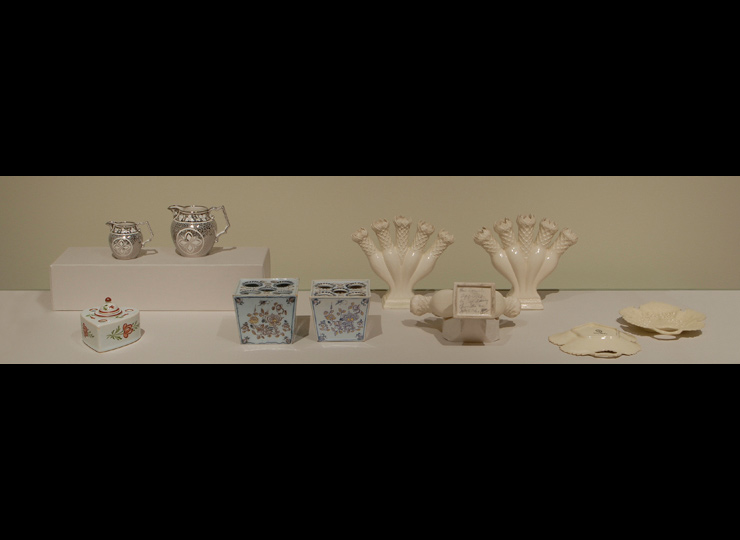Thorley copied the five forms seen here directly from antiques in Colonial Williamsburg’s collection. He used traditional technologies—the wheel, hand held sculpting tools, and slab-building techniques—to create master forms from which he made plaster molds. While these molds allowed him to reproduce exact replicas repeatedly, Thorley was unable or unwilling to produce enough pieces to fulfill the growing number of orders. As a result, Colonial Williamsburg terminated Thorley’s contract in 1956.
Thorley’s twentieth-century posy holder and flower brick are displayed here with the eighteenth-century antiques that he copied from Colonial Williamsburg. Thorley’s replicas very closely match the originals in color, shine, and detail. As the Craft House advertisement boasts, Thorley captured the blue cast of the original flower brick’s white glaze.
Inkstand, 1951-56
Colonial Williamsburg Foundation Craft House Reproduction
Earthenware
Lent by Twila and Michael Frieders Collection
Silver Resist Jugs, 1938-1956
Colonial Williamsburg Foundation Craft House Reproduction
Earthenware
Lent by Clark Taggart Collection
Flower Brick or Jardiniere, ca. 1740
Maker Unknown
Staffordshire, England
Tin-glazed Earthenware
Lent by the Colonial Williamsburg Foundation, 1938-17, 1
Flower Brick or Jardiniere, 1942-1955
Colonial Williamsburg Foundation Craft House Reproduction
Earthenware
Posy Holder or Quintal, ca. 1760 [back left]
Maker Unknown
Staffordshire, England
Earthenware (creamware)
Lent by the Colonial Williamsburg Foundation, 1939-103
Posy Holders, 1946-56
Colonial Williamsburg Foundation Craft House reproduction
Earthenware
Lent by Clark Taggart Collection
Sweetmeat Dishes, 1952-1956
Colonial Williamsburg Foundation Craft House Reproduction
Earthenware
Left: Lent by Clark Taggart Collection
